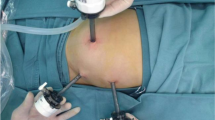Abstract
Background
Laparotomy has been the traditional approach for the treatment of adult intussusception. The aim of the present study was to compare the short-term clinical outcomes of laparoscopic surgery to those of open surgery in adult patients with intussusception.
Methods
We retrospectively reviewed data of all adult patients with intussusception admitted to our hospital between 2007 and 2017. The patients’ characteristics, presentation, operation details, postoperative outcomes and pathology were analyzed. Comparisons were made between the laparoscopic and open surgery procedures performed during the study period.
Results
Seventeen open and 20 laparoscopic-assisted resections were performed. No significant differences were found between the two groups for the following parameters: age (45.3 ± 16.8 vs. 54.9 ± 19.1, p = 0.160); gender (41 vs. 60% males, p = 0.330); American Society of Anesthesiologists score (p = 0.609); history of cardiovascular disease (5.9% vs. 5.6%, p = 0.950), COPD/asthma (0% vs. 5.6%, p = 0.950), diabetes (11.8% vs. 11.1%, p = 0.950), and renal impairment (5.9% vs. 0%, p = 0.486); body mass index (20.6 vs. 21.9, p = 0.433); timing of presentation (p = 1.000); type of intussusception (p = 0.658); type of procedures (p = 0.446); operative time (173.7 ± 45.4 vs. 191.5 ± 43.9, p = 0.329); and length of postoperative stay (6.7 ± 5.4 vs. 4.5 ± 1.1 days, p = 0.153). However, the open surgery group had fewer patients with hypertension (17.6% vs. 61.1%, p = 0.009) and demonstrated a delayed oral intake (4.0 ± 1.7 days vs. 2.5 ± 0.7 days, p = 0.010) and a higher comprehensive complication index (11.5 ± 27.1 vs. 0, p = 0.038).
Conclusions
The laparoscopic approach was associated with earlier oral intake and a lower comprehensive complication index. It is a safe and feasible technique that confers the advantages of minimally invasive surgery. It can be considered the preferred surgical option when the surgical expertise is available.
Similar content being viewed by others
References
Begos DG, Sandor A, Modlin IM (1997) The diagnosis and management of adult intussusception. Am J Surg 173:88–94
Siow SL, Mahendran HA (2014) A case series of adult intussusception managed laparoscopically. Surg Laparosc Endosc Percutan Tech 24:327–331
Siow SL, Chea CH, Hashimah AR, Ting SC (2011) Adult intussusception: 5-year experience in Sarawak. Med J Malays 66:199–201
Kim JW, Lee BH, Park SG, Kim BC, Lee S, Lee SJ (2018) Factors predicting malignancy in adult intussusception: an experience in university-affiliated hospitals. Asian J Surg 41:92–97
Honjo H, Mike M, Kusanagi H, Kano N (2015) Adult intussusception: a retrospective review. World J Surg 39:134–138
Goh BK, Quah HM, Chow PK et al (2006) Predictive factors of malignancy in adults with intussusception. World J Surg 30:1300–1304
Palanivelu C, Rangarajan M, Senthilkumar R, Madankumar MV (2007) Minimal access surgery for adult intussusception with subacute intestinal obstruction: a single center’s decade-long experience. Surg Laparosc Endosc Percutan Tech 17:487–491
El-Sherif OF (1998) Laparoscopy in the management of an adult case of small bowel intussusceptions. Surg Laparosc Endosc 8:21–25
Cunningham JD, Vine AJ, Karch L, Aisenberg J (1998) The role of laparoscopy in the management of intussusception in the Peutz-Jeghers syndrome: case report and review of the literature. Surg Laparosc Endosc 8:17–20
Dindo D, Demartines N, Clavien PA (2004) Classification of surgical complications: a new proposal with evaluation in a cohort of 6336 patients and results of a survey. Ann Surg 240:205–213
Slankamenac K, Graf R, Barkun J, Puhan MA, Clavien PA (2013) The comprehensive complication index: a novel continuous scale to measure surgical morbidity. Ann Surg 258:1–7
Saw EC, Ramachandra S (1993) Laparoscopically assisted resection of intussuscepted Meckel’s diverticulum. Surg Laparosc Endosc 3:149–152
Targarona EM, Balague C, Knook MM, Trias M (2000) Laparoscopic surgery and surgical infection. Br J Surg 87:536–544
Yamamoto S, Fujita S, Ishiguro S, Akasu T, Moriya Y (2008) Wound infection after a laparoscopic resection for colorectal cancer. Surg Today 38:618–622
Horiuchi T, Tanishima H, Tamagawa K et al (2010) A wound protector shields incision sites from bacterial invasion. Surg Infect (Larchmt) 11:501–503
Kang SI, Oh HK, Kim MH et al (2018) Systematic review and meta-analysis of randomized controlled trials of the clinical effectiveness of impervious plastic wound protectors in reducing surgical site infections in patients undergoing abdominal surgery. Surgery 164:939–945
Zhang L, Elsolh B, Patel SV (2018) Wound protectors in reducing surgical site infections in lower gastrointestinal surgery: an updated meta-analysis. Surg Endosc 32:1111–1122
Nagorney DM, Sarr MG, McIIrath DC (1981) Surgical management of intussusception in the adult. Ann Surg 193:230–236
Alexander R, Traverso P, Bolorunduro OB et al (2011) Profiling adult intussusception patients: comparing colonic versus enteric intussusception. Am J Surg 2002:487–491
Acknowledgements
We would like to thank the Director-General of Health, Malaysia for his permission to publish this article.
Author information
Authors and Affiliations
Corresponding author
Ethics declarations
Disclosures
Drs. Sze Li Siow, Zhen Qiang Goo, Hans Alexander Mahendran, and Chee Ming Wong have no conflicts of interest or financial ties to disclose.
Additional information
Publisher's Note
Springer Nature remains neutral with regard to jurisdictional claims in published maps and institutional affiliations.
Rights and permissions
About this article
Cite this article
Siow, S.L., Goo, Z.Q., Mahendran, H.A. et al. Laparoscopic versus open management of adult intussusception. Surg Endosc 34, 4429–4435 (2020). https://doi.org/10.1007/s00464-019-07220-z
Received:
Accepted:
Published:
Issue Date:
DOI: https://doi.org/10.1007/s00464-019-07220-z




